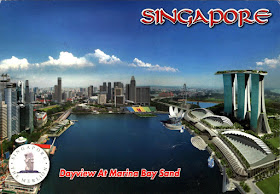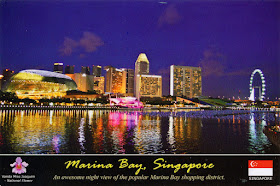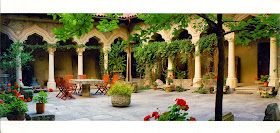Page
▼
November 30, 2014
1347 INDONESIA (Lesser Sunda) - Cultural Landscape of Bali Province: the Subak System as a Manifestation of the Tri Hita Karana Philosophy (UNESCO WHS)
Subak is the name of water management (irrigation) system for paddy fields on Bali island, which was developed more than 1,000 years ago. For Balinese, irrigation isn't simply providing water for the plant's roots, but water is used to construct a complex, pulsed artificial ecosystem. Paddy fields in Bali were built around water temples and the allocation of water is made by a priest. Included in the landscape is the 18th-century Royal Water Temple of Pura Taman Ayun, the largest and most impressive architectural edifice of its type on the island. The subak reflects the philosophical concept of Tri Hita Karana, which brings together the realms of the spirit, the human world and nature. This philosophy was born of the cultural exchange between Bali and India over the past 2,000 years and has shaped the landscape of Bali.
November 29, 2014
1345 BAHAMAS - Nassau beaches
 |
| 1345 Nassau beaches |
I wrote a few words about Nassau here, but besides the old town, the capital of Bahamas offers many beautiful hotels and resorts, all surrounded by tropical paradise and endless sunshine. It has a hotel district, named Cable Beach, recognizable by five enormous hotels - two of which are all-inclusive - located on this strip. The area is also known for its dining, the Crystal Palace Casino, and the golden sands of Cable Beach.
November 28, 2014
0759, 2364 SINGAPORE (Central Region) - Marina Bay
 |
| 2364 Marina Bay seen from The Promontory, with Marina Bay Sands on the right |
Marina Bay is located in the Central Area of Singapore surrounded by the perimeter of four other planning areas, the Downtown Core, Marina East, Marina South and Straits View. The area surrounding the bay itself, also called Marina Bay, is an extension to the adjacent Central Business District. It is also the new downtown of Singapore built on reclaimed land. Famous landmark iconic buildings include the Marina Bay Sands, Marina Bay Financial Centre, Asia Square, The Sail@Marina Bay and Marina One integrated mixed-use developments.
 |
| 0759 The north shore of Marina Bay, with Esplanade-Theatres on the Bay, Marina Centre and Singapore Flyer |
On the north shore of Marina Bay, in which flows Singapore River, is Esplanade - Theatres on the Bay, built to be the centre for performing arts for Singapore and completed in 2002. The unique architectural design has been said to have an appearance similar to either a durian or the eyes of a fly. Hence, the building is colloquially known to locals as "the durians". Between the Esplanade and the Singapore Flyer is spanning Marina Centre, a zone of reclaimed land which contains Suntec City, Marina Square, Millenia Walk, and Millenia Tower (218m - completed in 1996), with the roof in the form of a truncated cone.
November 27, 2014
1344 VANUATU (Tanna Island) - Yasur Volcano
"Opened in May 2005, the postal outlet on Tanna Island's Mt Yasur is recognised as the only post box in the world on a live volcano. Known as Volcano Post, this follows the famous Underwater Post Office in the second of Vanuatu Post's Xtreme series of unique and innovative postal facilities where official mail is collected, specially postmarked and sent throughout the world. The incredible postal locations enable visitors to mail home memories of Vanuatu's breathtaking sights and adventures. [...] All mail receives a unique Volcano Post cancellation, which will become sought-after items amongst the world's stamp collectors. [...] Imagine showing your friends a postcard from the Volcano Post Box, which was sent to you just a lava rock's throw from molten lava with temperatures over 1000°C!" Between you and me, if they strove to open a post office on a volcano, they could apply the postmarks in a correct way, not randomly and incomplete.
November 25, 2014
1343 BOTSWANA - Moths
This postcard depicts a shaped miniature sheet comprising a series of stamps issued on July 19, 2000, Moths of Botswana:
Mopane moth / Gonimbrasia belina (35t) - is a moth of the Saturniidae family, which is found in much of Southern Africa. Its large edible caterpillar, the mopani or mopane worm (found on the mopane tree, Colophospermum mopane), is an important source of protein for millions of indigenous Southern Africans. Its wingspan is about 120mm. It is fawn through shades of green and brown to red, with two black and white bands isolating eye spots. Orange eyespot on each hind wing. Males have feathery antennae.
November 24, 2014
1342 JAPAN (Kyūshū) - Mount Aso
Mount Aso, located in Aso Kujū National Park, is the largest active volcano in Japan, and is among the largest in the world, with one of the largest calderas (25km north-south and 18km east-west), which contains the city of of Aso as well as Aso Takamori-cho and South Aso-mura. The central cone group consists of five peaks: Mt. Neko, Mt. Taka (the highest, with 1592m), Mt. Naka (also called Nakadake or Naka-Dake), Mt. Eboshi, and Mt. Kishima. Only the northernmost crater has been active for the last 70 years, last time in 2011. Viewpoints from the somma overlooking the caldera are perched upon lava formed before the volcanic activity which created the present caldera. Ejecta from the huge caldera eruption 90,800 years ago covers more than 600 km³ and roughly equals the volume of Mt. Fuji; it is presumed that the pyroclastic flow plateau covered half of the island of Kyūshū.
November 23, 2014
1340 AUSTRALIA (Tasmania) - West Coast Wilderness Railway
 |
| 1340 West Coast Wilderness Railway in Tasmania |
The West Coast Wilderness Railway is a reconstruction of the Mount Lyell Mining and Railway Company railway between Queenstown and Regatta Point, Strahan, in Tasmania, now operating as a tourist experience with a focus on sharing the history of the Tasmania's West Coast. Following track rehabilitation work, the railway was re-opened between Queenstown and Dubbil Barril on 6 January 2014, while rehabilitation of the section through to Strahan continues. This railway is significant because of its Abt system to conquer the mountainous terrain through rainforest, with original locomotives still operating on the railway today.
November 22, 2014
1339 THAILAND (Loei) - Wat Si Khun Mueang temple in Chiang Khan
Chiang Khan, the capital of the district with the same name in Loei Province, is a small city located at 580km north of Bangkok. It's hard to get many facts about Chiang Khan, other than it has a handful of fine, old Buddhist temples. Chiang Khan has boomed in the past four years, and even more so in the last two. It has well and truly been ‘discovered’ by urban Thais, many of them drawn to a nostalgic past that they never had: Buddhist monks at dawn receiving alms and sticky rice, rambling family homes made of ancient teak on streets of almost no vehicles, and local specialities like hand-sewn quilts and maphrao kaew (sugar-coated dried coconut) snacks.
November 18, 2014
1337, 1338 ROMANIA (Bucharest) - Stavropoleos Church
Stavropoleos Monastery, also known as Stavropoleos Church during the last century, when the monastery was dissolved, is an Eastern Orthodox monastery for nuns in central Bucharest. The name is a Romanian rendition of a Greek Stauropolis (The city of the Cross), and the patrons are St. Archangels Michael and Gabriel. It was built in 1724 in Brâncovenesc style, during the reign of Nicolae Mavrocordat (Prince of Wallachia between 1719 and 1730), by archimandrite Ioanichie Stratonikeas, came in from Epirus. Within the precinct of his inn, Ioanichie built the church, and a monastery which was economically sustained with the incomes from the inn (a relatively common situation in those times). The inn and the monastery's annexes were demolished at the end of 19th century. Over time the church suffered from earthquakes, which caused the dome to fall. The dome's paintings were restored at the beginning of the 20th century.
All that remained from the original monastery is the church, alongside a building from the beginning of the 20th century (constructed following the plans of architect Ion Mincu) which shelters a library, a conference room and a collection of old icons and ecclesiastical objects, and parts of wall paintings recovered from churches demolished during the communist regime. The library has over 10,000 Romanian, Greek, and Church Slavonic books of theology, byzantine music, arts and history, more than 80 manuscripts and 400 printed works. The Byzantine music books collection is the largest in Romania, and consists mostly of the donations of two Romanian byzantologists, Sebastian Barbu-Bucur, and Titus Moisescu. The community living here, besides routine worship, is engaged in renovating old books, icons and sacerdotal clothes. The music sung during the offices is neo-Byzantine, based on the works of 19th century Romanian psalmodists, Greek chants translated into Romanian, or modern compositions.
November 15, 2014
1336 TURKEY - A belly dancer
Belly dance is a translation of the French term "danse du ventre", applied to the dance in the Victorian era, and originally referred to the Ouled Nail dancers of Algeria, whose dance used more abdominal movements than the dances described today as "belly dance". Actually is a misnomer, because every part of the body is involved in the dance; the most featured body part is usually the hips. Belly dance takes many different forms depending on the country and region, both in costume and dance style, and new styles have evolved in the West as its popularity has spread globally.
November 13, 2014
1125, 1272, 1332 UNITED STATES (Utah) - Utah map and flag
Posted on 04.07.2014, 08.10.2014, and 13.11.2014
Bordered by Colorado, Wyoming, Idaho, Arizona and Nevada (and touching a corner of New Mexico), Utah, one of the Four Corners states, is well known as the most religiously homogeneous state in the Union (its nickname is Beehive State), approximately 62% of Utahns being members of The Church of Jesus Christ of Latter-day Saints or LDS (Mormons), which greatly influences the state's culture and daily life. The world headquarters of The Church of Jesus Christ of Latter-day Saints (LDS Church) is located in the state capital, Salt Lake City, founded in 1847 in proximity to the Great Salt Lake. It is a geographically diverse state, located at the convergence of three distinct geological regions: the Rocky Mountains, the Great Basin, and the Colorado Plateau. Utah is known for its natural diversity and is home to features ranging from arid deserts with sand dunes to thriving pine forests in mountain valleys.
Thousands of years before the arrival of European explorers, the Anasazi/Ancestral Pueblo and the Fremont tribes lived in what is now Utah. Around the 18th century, the Navajo settled in the region, and then other Uto-Aztecan tribes, including the Goshute, the Paiute, the Shoshone, and the Ute people (who gave the name of the state). Spaniards explored the region in the 16th century, but weren't interested in colonizing. In 1821 it became part of Mexico (Alta California), and in 1824 Jim Bridger became the first white person to sight the Great Salt Lake. In 1847 Brigham Young and the first band of Mormon pioneers came to the Salt Lake Valley, and over the next 22 years, more than 70,000 pioneers crossed the plains and settled in Utah.
The Mormons wanted to establish a State of Deseret, but many of the members of the U.S. government opposed their polygamous practices. Between May 1857 and July 1858 held an armed confrontation between Mormon settlers and the armed forces of the US government (the Utah War), and beginning in 1865 Utah's Black Hawk War developed into the deadliest conflict in the territory's history. In the 1890 Manifesto, the LDS Church banned polygamy, so when Utah applied for statehood again, it was accepted, it becoming the 45th state admitted to the Union on January 4, 1896.
1331 FRANCE (Provence-Alpes-Côte d'Azur) - Château d'If
The Château d'If is a fortress located on the island of If, the smallest island in the Frioul archipelago situated in the Mediterranean Sea about a mile offshore in the Bay of Marseille. It was built in 1524-1531 on the orders of King François I as a defence against attacks from the sea, and was instantly controversial. Marseille had been annexed to France in 1481, but the city retained in theory the right to provide her own defence. The new Château was to many people an unwelcome reminder of royal authority. Although it successfully repelled an attack on the port by Charles V of Spain in 1536, the cannons gradually proved inadequate to reach invading ships, so it became a prison in the mid-16th century. Subsequent inhabitants over the next 200 years included 3,500 Huguenots and a Monsieur de Niozelles who was given six years for failing to take his hat off in the presence of Louis XIV. Others were imprisoned without trial, for minor misdemeanours. The island became famous in the 19th century when Alexandre Dumas used it as a setting for The Count of Monte Cristo.
November 9, 2014
1329 AUSTRALIA (Christmas Island) - The annual red crab mass migration
 |
| 1329 The annual red crab mass migration in Christmas Island |
Located at 500km south of Indonesia, and at 1,560km from the town of Exmouth, the closest point of the Australian mainland, Christmas Island is quite isolated, so had a high level of endemism among its flora and fauna. Unfortunately two species of native rats have become extinct, the endemic Christmas Island Shrew has not been seen since the mid-1980s, while the Christmas Island Pipistrelle (a small bat) is critically endangered and possibly also extinct. Now the land crabs and sea birds are the most noticeable fauna on the island.
November 8, 2014
0658, 1328 MEXICO (Veracruz) - El Tajin, Pre-Hispanic City (UNESCO WHS)
Posted on 25.05.2013 and completed on 08.11.2014
In 1785, an official stumbled upon by chance the Pyramid of the Niches, in the highlands of the municipality of Papantla, in the low mountains that lead from the Sierra Madre Oriental to the Gulf coast near the Tecolutla River. It is unclear who built the city, but the site was known to the local Totonac, whose ancestors may also have built it, as El Tajín, which was said to mean "of thunder or lightning bolt". Related to this is their belief that twelve old thunderstorm deities, known as Tajín, still inhabit the ruins. Anyway, between 600 and 1200 C.E. it was a prosperous city, one of the largest and most important of the Classic era of Mesoamerica, that controlled much of what is now modern Veracruz state, advantaged by its strategic position along the old trade routes.
Considered to be crucial to the understanding of artistic and socio-economic development in the period between the Teotihuacan and Mexico-Tenochtitlan empires, and its architecture, characterized by elaborate carved reliefs on the columns and frieze, being unique in Mesoamerica, was designated a World Heritage Site by UNESCO in 1992, under the name El Tajin, Pre-Hispanic City. The settlement is divided into three areas, each constructed around a number of open spaces (plazas). The focus of the site is Pyramid of the Niches, which rises at 20m in 6 steps to a temple at the top, and has a wide staircase rising up its eastern side. Each storey has rows of square niches with overhanging cornices, 365 in total, one for each day of the solar year. The staircase is bordered by a step-and-fret motif; probably representing lightning.
November 1, 2014
1326 SINGAPORE - Traditional Chinese street opera players
Wayang (a Malay word meaning "a theatrical performance employing puppets or human dancers") commonly refers to Chinese street opera in Singapore, though it is also used in reference to other forms of opera such as wayang kulit. In Mandarin, Chinese street opera is known as jiexi (street show). This traditional Chinese dramatic form, which incorporates a wide range of art forms like song, dance, mime, acrobatics and martial arts, was brought to Singapore by immigrants from China during the 19th century as part of their religious rites.
1325 CUBA - Old Havana and its Fortification System (UNESCO WHS)
Havana extends mostly westward and southward from the bay with the same name, which is entered through a narrow inlet and which divides into three main harbours. The Almendares River traverses the city, entering the Straits of Florida a few km west of the bay. Founded by the conquistador Diego Velázquez de Cuéllar in 1514 or 1515, it was originally a trading port and suffered regular attacks by by buccaneers, pirates, and French corsairs, but subsequently, due to its strategic location, it served as a springboard for the Spanish conquest of the continent.






















%2B-%2BThe%2Bmap%2Band%2Bflag%2Bof%2BState%2Bof%2BUtah.jpg)
%2B-%2BThe%2Bmap%2Band%2Bflag%2Bof%2BState%2Bof%2BUtah%2Bspate.jpg)












